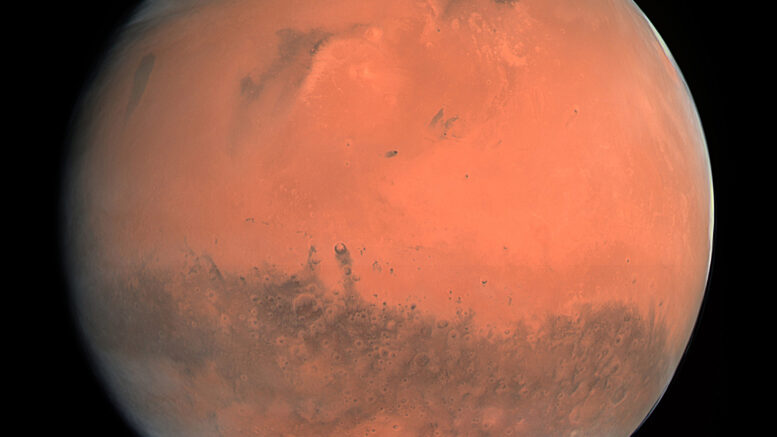Mars is the fourth planet from the Sun and the second-smallest planet in the Solar System, being only larger than Mercury. In English, the planet is named after the Roman god of war and is often referred to as the “Red Planet”. The “Red Planet” nickname is in reference to the effect of the iron oxide prevalent on Martian surface, which gives it a reddish appearance distinctive among the astronomical bodies visible to the naked eye. It is a terrestrial planet with a thin atmosphere, with surface features reminiscent of the impact craters of the Moon and the valleys, deserts and polar ice caps of Earth.
| Value | |
| Size | 4,220 miles |
| Distance To The Sun | 142 million miles or 1.527 AU |
| Length of A Day | 24 hours 37 minutes |
| Length Of A Year | 687 Earth days |
| Temperature (Lows and Highs) | Lows: −226°F Highs: 95°F |
| Number Of Moons | 2 |
| Number Of Rings | 0 |
| Missions To The Planet | 3 |
| Atmosphere | Mostly carbon dioxide, some water vapor |
| Size Compared To Earth | Roughly Half As Small As Earth |
| Discoverer And Discovery Date | Known By Ancients |
Moons
Mars has 2 moons, named Phobos, which is about 14 miles in diameter, and Deimos, which is about 7.5 miles in diameter. These 2 moons orbit close to the planet Mars, which has led to many theories about how they came to form. Although their origins remain uncertain, scientists and astronomers have favored asteroid capture as the main theory. Both moons were discovered by Asaph Hall in 1877, and named after characters in Greek Mythology. Phobos and Demos would accompany their father Ares, god of war, into battle. Mars was the Roman counterpart of Ares.
Fun Facts
- It would take more than 6 Mars to fill the volume of Earth
- Mars has 1/10th the mass of the Earth
- For astronauts on Mars, they would experience 62.5% less gravity than one would experience on the Earth
For more information on Mars Exploration by NASA, check out https://mars.nasa.gov
Check out the Planetary Bodies Category for previous and upcoming articles on the solar system planets.

Be the first to comment on "Mars: A Brief Overview"